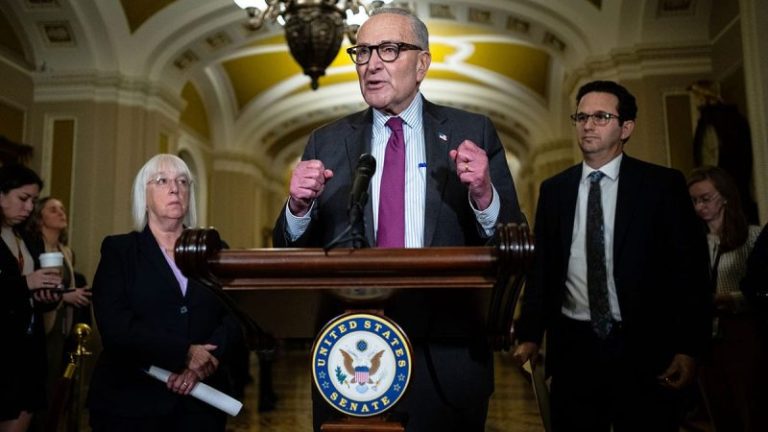The Senate is in for a rare weekend session as the chamber remains in limbo while lawmakers try to find a way out of the government shutdown.
Behind the scenes, appropriators are cooking up a trio of spending bills to attach to the House-passed continuing resolution (CR), along with an extension to the bill that would, if passed, reopen government until December or January.
But the package was not ready for primetime Saturday, and no votes were held. Instead, Senate Republicans spent hours railing against Obamacare and Senate Democrats’ desire to extend the expiring premium subsidies on the floor.
When the package does hit the floor, Senate Democrats, as they’ve done 14 times previously, are likely to block it. It all comes as the upper chamber is scheduled for a week-long recess to coincide with Veterans Day.
Senate Majority Leader John Thune, R-S.D., now wants to keep lawmakers in town until the shutdown ends.
When asked if there would be a vote on the plan, Thune said it would be ideal to have the package on the floor, but ‘we’ve got to have votes to actually pass it.’ Republicans are reticent to put the CR out again just to see it fail.
‘I’ve been talking all morning with some of the folks that are involved with the meeting, and I think we’re getting close to having it ready,’ Thune said. ‘We just need to get the text out there.’
The spending package, however, is just one piece of the puzzle to reopening the government.
Senate Minority Leader Chuck Schumer, D-N.Y., and his caucus, freshly emboldened by sweeping Election Day victories earlier in the week, are sticking by their newly released plan that would extend the expiring Obamacare subsidies by one year and create a bipartisan working group to negotiate next steps after the government reopens.
But Senate Republicans immediately rejected the idea; Thune called it a ‘non-starter,’ while others in the GOP were angered by the proposal.
Sen. Eric Schmitt, R-Mo., said he would appeal to President Donald Trump and his administration to slash funding from ‘pet projects’ in blue states and cities to pay federal workers as the shutdown drags on.
‘The idea that you’ve got a bunch of kamikaze pilots trying to burn this whole place down because they’re emboldened by an election where Democrats won in Democrat areas is totally insane,’ he said.
Senate Democrats were largely unsurprised that Republicans rejected the offer, however.
‘I know many Republicans stormed out of the gate to dismiss this offer, but that’s a terrible mistake,’ Schumer said.
Thune and his conference have, throughout the course of the 39-day shutdown, said they would only deal with the subsidies after the government reopened and have offered Schumer and Senate Democrats a vote on a bill addressing the healthcare issue once the closure ends.
‘I’m not surprised,’ Sen. Mark Kelly, D-Ariz., said. ‘They don’t want to help people with their healthcare.’
But Republicans countered that a simple extension of the enhanced subsidies, which were modified under former President Joe Biden during the COVID-19 pandemic, would funnel money straight to insurers.
Sen. Katie Britt, R-Ala., has been in talks with Senate Democrats on a path forward, particularly through jump-starting government funding with the impending trio of spending bills.
After Schumer unveiled Democrats’ plan, she charged that ‘since Obamacare came into effect, look who’s gotten rich? It’s not the people.’
‘They’re talking about the people’s premiums and have … they have taken it to the companies that are actually making the money off of it? They’re not,’ Britt said. ‘So, I look forward to hearing why in the world they want to continue these profits and not actually help the people they serve.’
Senate Democrats, however, contend that their offer was fair.
Sen. Chris Murphy, D-Conn., argued that there were some in the caucus that wanted to do a multi-year extension, while others wanted to go beyond just the enhanced subsidies. He reiterated his frustration that the core of the issue, from his perspective, was that neither Schumer nor Thune would sit down and negotiate.
‘We made a really simple, really scaled-down offer that could get the government up and operating and [is] really good for them politically,’ he said. ‘I just still don’t understand why they won’t accept the offer.’










